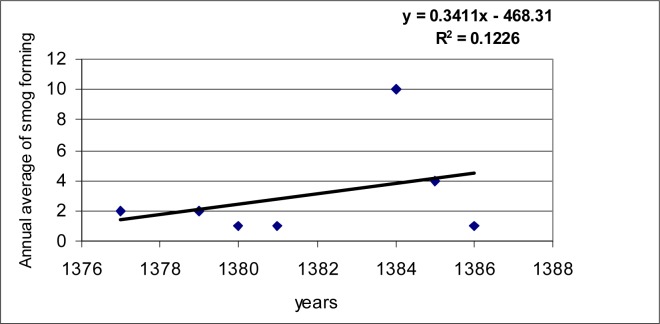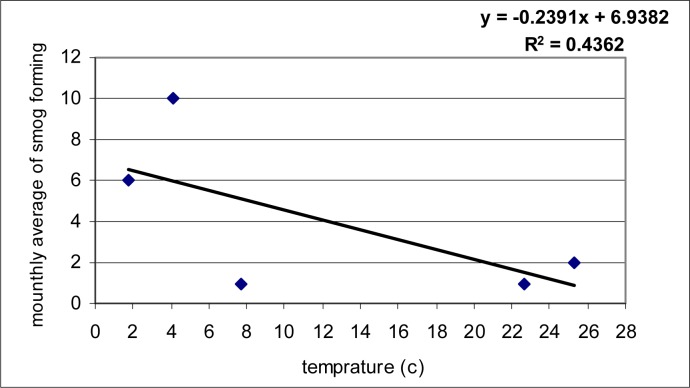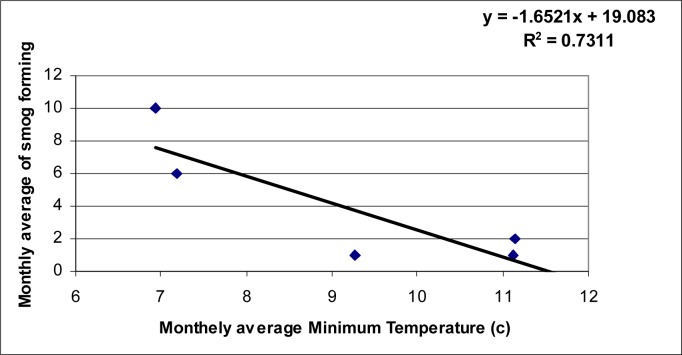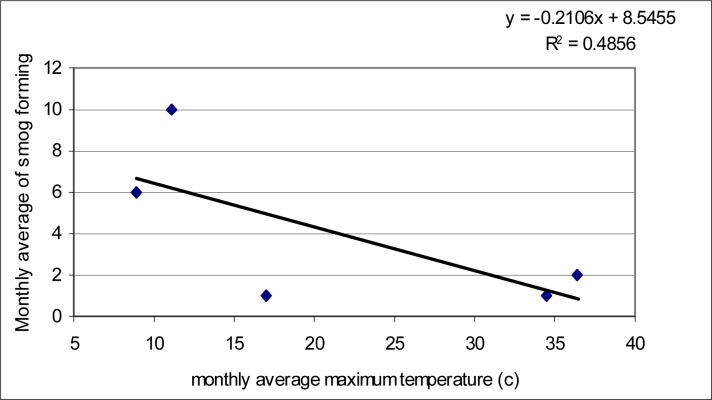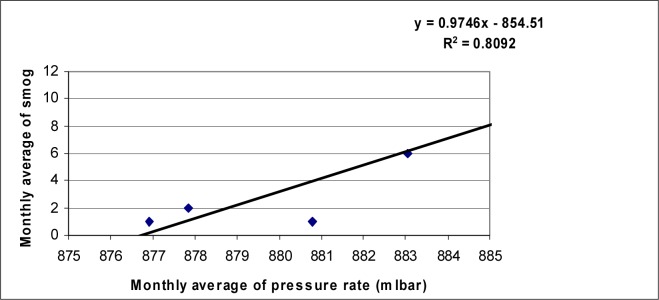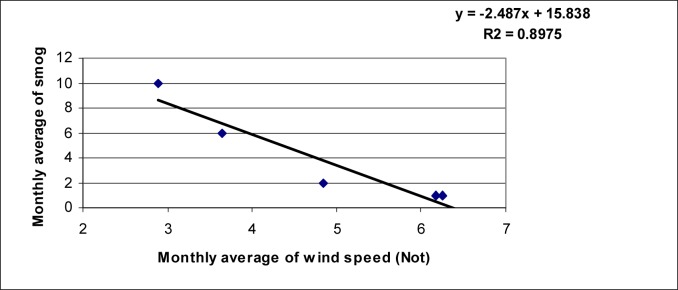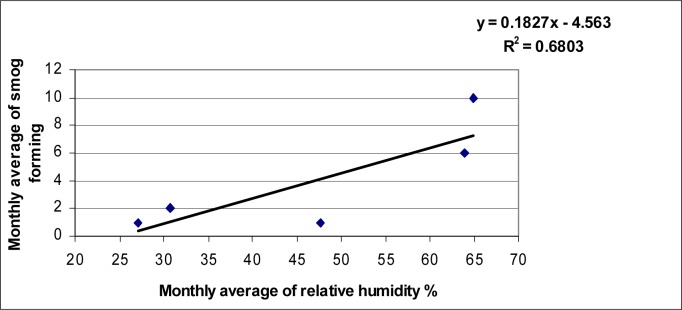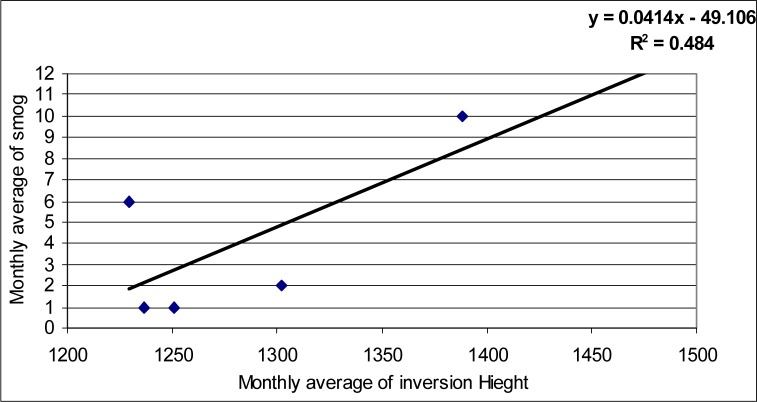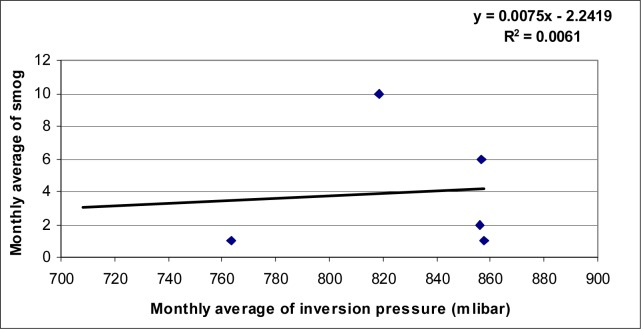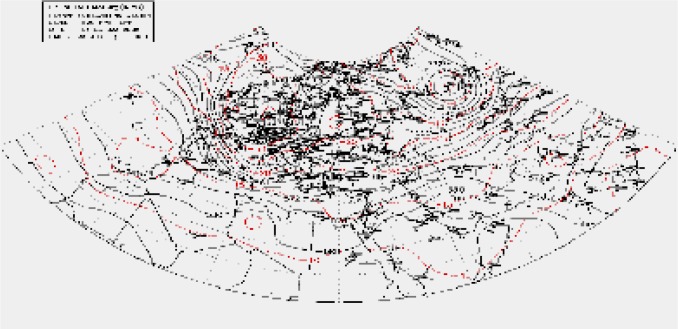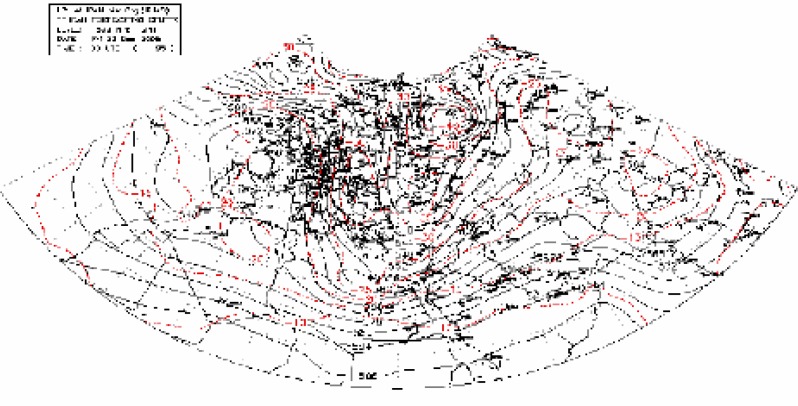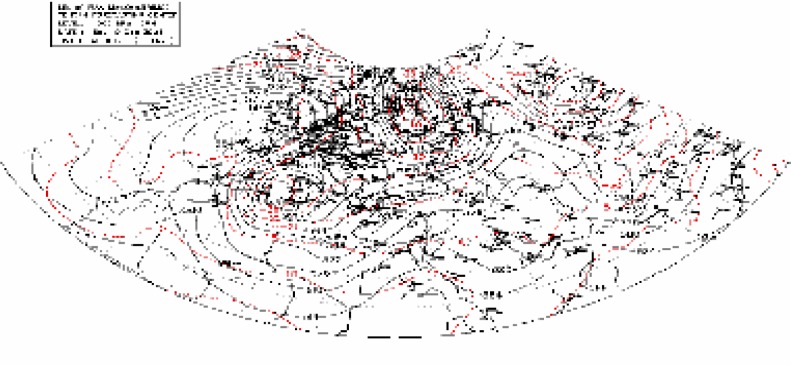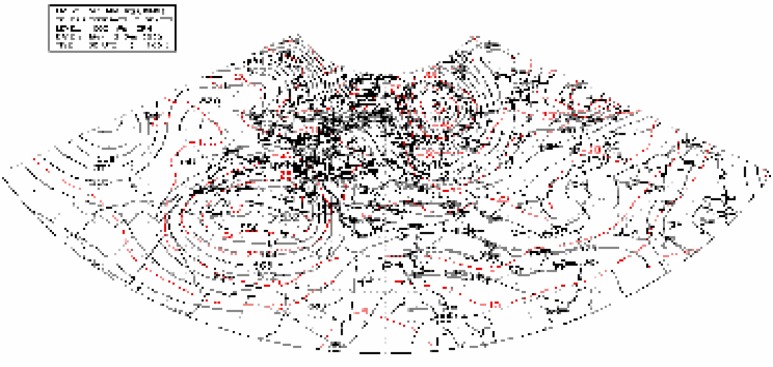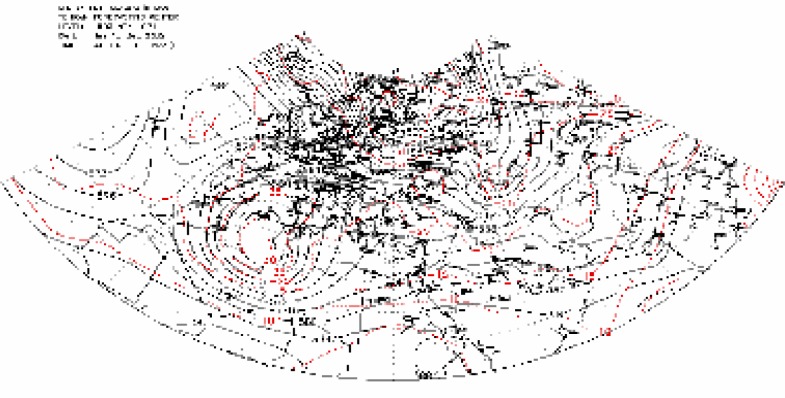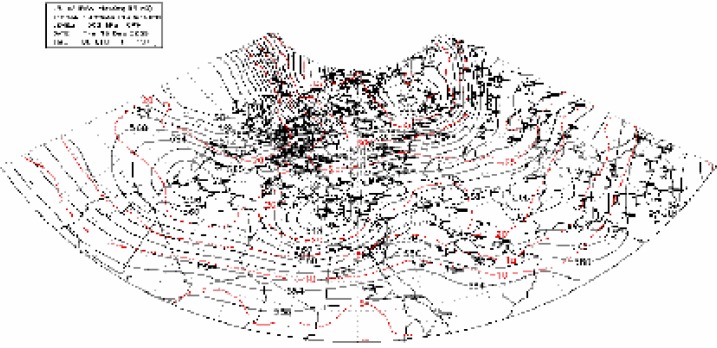Abstract
Air pollution is one of the most important problems in urban areas that always threaten citizen’s health. Photochemical smog is one of the main factors of air pollution in large cities like Tehran. Usually smog is not only a part of nature, but is being analyzed as an independent matter, which highly affects on the nature. It has been used as relationship between atmospheric elements such as temperature, pressure, relative humidity, wind speed with inversion in the time of smog forming and weather map in 500 Hpa level during 9 years descriptive static by using correlation coefficient in this analyze. Results show that there is a meaningful correlation between atmospheric elements and smog forming. This relation is seen between monthly average of these elements and monthly average of smog forming. However, when temperature decreases, corresponding pressure will increase and result of this will be smog forming. Usually smog increases in cold months of year due to enter cold high pressure air masses in Iran during December and January that is simultaneous with decreasing temperature and air pressure increases and inversion height distance decreases from the earth surface which cause to integrate air pollution under its surface, will cause to form smog in Tehran. It shows a meaningful and strong relation, based on resultant relations by correlation coefficient from inversion height and smog forming, so that obtained figure is more than 60% .
Keywords: Photochemical smog, Urban climatology, Inversion, Air pollution, Weather maps, Iran
Introduction
Air is one of the most basic factors of life but this natural factor when is polluted, is appeared as an enemy of nature and human. Air pollution is one of the most important current problems of human. Photochemical smog has mostly influenced the attentions among various problems of air pollution. The photochemical smog has been resourced from applied work from smog in Los Angeles (1) expressed a hypothesis according which, existing smog pollutants of Los Angeles, were not directly radiated from sources, but was resulted from photochemical reactions on radiated pollution from sources (2). This hypothesis highly justifies the smog of loss Angeles and its signals. Primary researches, introduced nitrogen oxides as the main reason of photochemical smog produced in the stationary air and ultra violet light of sun and via ozone which is the most important substance in photochemical smog. The next researches showed that hydrocarbons will also affect on photochemical smog and presented comparability for all of efficient reactions (3). Photochemical smog is one of the most air pollution factors in large cities of the world (4). The weather in these cities is suitable to form photochemical smog, because photochemical smog is a phenomenon which hydrocarbons and nitrogen oxides, sun light and atmosphere stationary are needed and all of these agents exist in Tehran all days. Smog is a combination of smoke and fog and is a kind of air pollution, which is formed with sunny days and affects on people and other live animals (5). Photochemical smog is a kind of pollution, a complicated combination of air pollution, which sometimes are seen in the surface of industrial cities as a yellow and brown fog. This combination is formed in industrial cities in which fuel materials are mostly consumed (6).
The subjects related to cities and different problems of urban life have been considered more than a century by geographers. Urban climate has an important role in human life in the earth. Improving such conditions, various researches have been done and hundreds cities have been studied (7). However, these studies are presented no longer than a century, while the air pollution is not a new phenomenon. In Roman philosopher’s results, severe weather and bad smell of chimneys have been taunted and found that they will feel better far from this pollution. In 1272, first Edward, King of England prohibited to fire coal during parliament meeting in London and in 1578, Queen Elizabeth complained of coal fuel to parliament. The first, second and third seminars of air pollution were established in London in 1819, 1843 and 1845. The first article about air pollution via automobiles was published in 1919. Probably the word smog was applied by a medicine doctor health conference in 1905 to imply the bad quality of air due to combination of fog and smoke in 1930. A polluted air covered the city in Muse Valley in Belgium, for 3 days and caused more than 60 deaths. In 1931, more than 593 persons died in Manchester and Halford in 9 days. London’s smog 1952 (from December 5 to 9), during which 4000 persons died, was the most famous air pollution events due to temperature inversion because of extreme fog and smoke. These events are all resultants from extremely air pollution due to much density of sulfur oxide and suspense substances (8),considered photochemical smog problem and believes that its increases is related with fast increasing in atmospheric pollution.
The important factors of photochemical smog generated concentration rate of high atmosphere were considered, so that traffic jam in beginning of day and sunlight intensity in the next hours will cause to generate Proxy Still Nitrate and forming smog. In addition, climatic factors such as rainfall, wind, daily temperature range, and topography have a key role in forming and continuing photochemical smog (9). Smog forming sources, ozone, air pollution, public health, air pollution in Canada and international efforts for decreasing air pollution have been considered. Ozone increases due to temperature raising and high sun light under special geographical conditions. In addition, long term and short-term effect of air pollution will affect highly on human health (10). Photochemical smog is a phenomenon, which needs the combining of nitrogen oxides and hydrogen oxides existence, so that hydrogen oxides will be activated in the presence of sun light and will produce a combination of chemical smog will cause and produce thousands of dangerous chemical substances. An air pollution international seminar with representatives of worldwide health organization in Tehran was established on May 2005 (11, 12). introduced photochemical smog as one of the main factors of air pollution in large cities like Tehran, and they resulted that weather conditions of this city was completely suitable to form photochemical smog, because photochemical smog is a phenomenon for which hydrocarbons, hydrogen oxides, sunlight and stationary atmosphere is needed and all of these factors often exist in Tehran (13) concluded that there are various factors which cause to form photochemical smog which HC and NOx are the most important of sun radiation. Industrial units have important role to form photochemical smog, because they largely generate NOx and HC.
This phenomenon is seen in some large cities like Los Angles, Vancouver, Mexico City, Tokyo, Johannesburg, and Tehran. It has been tried to analyze atmospheric processes in photochemical smog forming, based on fundamental studies and statistical methods in this paper.
The region under studying is Tehran is located between 35° ◌35′ ◌to 35° ◌48′ ◌northern latitude and from 51° ◌17′ ◌to 51° ◌33′◌ 35′◌ 35′ ◌to 35° ◌48′◌N and from 51° ◌17′ ◌to 51° ◌33′ ◌E of eastern longitude and with area about 800 square kilometer in the southern part of Alborz mountains (14). There are different factors affecting on Tehran air pollution among them geographical factors are more important. Tehran has located in southern parts of Alborz in a semi closed region (15, 16). Alborz Mountains surrounded north and northeast of Tehran like a dam, which act against western winds and causes to remain all pollution on the city surface. Tehran is affected by Alborz Mountains, different inversions and continental high pressure systems, so Tehran air pollution cannot be reduced or removed by natural conditions of area. Tehran acts as thoughtful and managing centre of country and most of politics and policy are done from there, so it will be very important if air be clean and provide a suitable environment for thinking and decision making (17).
Problem Design
Urban development, air pollution, and urban climate are the most important subjects about cities (18–26). Air pollution is defined as an undesired change in air physical, chemical, and biological properties, which will damage health, existence and human activities or other live animals. According to this definition, pollution is not essentially of physical damages (27). Entering artifacts due to substances or energy into nature, which will result damages for human health, will cause damage to the structure of nature or undesired using of it (28). Population growth and its density in large cities, simultaneity with advancement in technology and using of fossil fuel (causes cities pollution) for human health societies is a very important threat. Various cities have different types of pollution and atmospheric conditions, so that the air quality is dependent on different parameters such as local atmospheric condition. Tehran has been polluted because of physical developing its population growth, providing new building and facilities like productive manufacturers and air pollution industries units in the city and automobile increases has caused these factors for Tehran. We have tried to evaluate and determine the relation between weather factors and smog forming in Tehran by using statistical information during nine years.
Research Particular Questions
Since beginning of social life, man enhanced the life, besides these enhancements, encountered with air pollution problem. Of course, type, quality, and quantity of pollution depend on cultural, social, and economical structure of a city or country. So far, it has not been observed photochemical smog in Tehran such as Los Angeles, London, and New York, which have been occurred in 1950, and 1960. Some days in Tehran, we encounter to smog due to extremely integration of population and industrial units. Now, according to Tehran air pollution and several photochemical smog occurring in Tehran, the following questions are planned:
Are there strong relationship between climatic elements such as air pressure, relative humidity, temperature, wind, speed, inversion in smog forming rate of Tehran?
Does high-pressure entrance into Tehran affects intensify smog and condense?
Photochemical smog forming
Atmosphere is the biggest reactor in the world that many reactions are done it, inside there will be photochemical, and chemical reactions that convert radiated pollution from sources to other pollutions, which have fundamental role in photochemical smog forming. Existing oxygen in high density atmosphere (about 130 hg mm),and pollution with density less than 10 ppm or 10−2 hg mm will cause radiation in present of ultra violet sun light that these reactions are results of difference in densities and are of initial reactions of photochemical smog forming :
These reactions determine many are an attractive factor of released heat from reaction. These two reactions are the first reaction which starts with sunrise and morning traffic the next reaction is the following fast reaction:
Hydrocarbons existence, especially Olefins and Aldouids will cause other reactions, which have important role in photochemical smog forming (29, 30).
Photochemical smog development factors
Pollution is defined one or several pollutant materials in free space to change quality of weather to dangerous level for human, animals, plants and buildings:
1-Nitrogen source and released organic combinations, combining high density of this material with industrializing and transportation are important factors forming photochemical smog. These factors cause some pollution to form in atmosphere by combustion fossil fuel. 2-Time is one of the most determining factors to determine density rate of photochemical smog in atmosphere. Density rate of nitrogen oxide and erosive organic combinations and ozone generating, depends on the following factors:
Nitrogen oxides rate will increase by heavy traffic in beginning of day and organic combinations release in to atmosphere.
Traffic density will decrease after initial hours of day, and nitrogen oxides and released organic combinations will start forming nitrogen oxides and eventually increases its density. Solar radiation intensity increases in day times, nitrogen oxides with releasing organic combinations will cause to produce chemical material as nitrates fuel proxy (8).
3- Climatic factors have various effects on photochemical smog. In warm days, especially in summer, with low pressure difference, especially weather circulation will appear and wind direction is formed from suburb to city centre and warm air will raise in centre then cold air flow enter to city from suburb area. As a result, cold weather will flow from around of warm nucleus, because of the lowest air pressure is dominated since this type of air circulation pattern is under polluted surface of city, it will not be able to refine polluted air of city.
Temperature and, solar radiation of location may affect on type and rate of atmosphere chemical reactions. Thus, solar radiation and temperature resultant have important role to photochemical smog forming. Usually air becomes warm during daytime and moves to Therefore, it will be reduce vertical shifting of pollutions, thermal changing may continue from several days to several weeks (13).
Pressure Patterns
It will not be changes in nature unless occurring due to changing in pressure patterns (31–33). Heat island intensity, inversion layers and wind direction are controlled by pressure pattern, for example, when high pressure is dominated in Tehran, is formed stable weather and air pollution cannot raise even though inversion layers exit in high surface. As a result, the weather will be polluted, while in the low-pressure condition, air will be clean in the most intensify day (34). Tehran and north of country are under high pressure and stable weather. Pollutants in autumn and winter are more than other seasons. In addition, anticyclone systems are causes the stable weather in autumn and winter (34).
Wind speed and direction
The Mehrabad weather synoptic stations data shows that major wind of Tehran is western type, which control climate of Tehran. Seventy percent of the winds in Tehran are calm and have not especial direction, due to various factors. Thirty percent of winds which are stronger are mainly from west, wind speed and direction shows that any pollution source in west of Tehran will result air pollution in city and second winds are southern. Western and southern winds bring pollutant materials to centre from each side, thus city centre has a high pollution potential (17).
Relative humidity distribution
Relative humidity distribution is one of important parameters affecting on environment temperature. On the other hand, water vapor affects on quality of air. When relative humidity is high in earth surface, it absorbs water vapor and causes its latent in troposphere (2 km above surface). In addition, humidity will cause to form fog and will be increased air pollution (35).The existence of high humidity in environmental air with chemical pollutants, plays an important role to smog form (36).
Inversion
Inversion is the most important effective climatic factors of air pollution in Tehran, which is provided in two forms of, radiation and synoptic. Radiation inversion are made due to earth cooling (37) and synoptic inversion is mainly resultant from atmospheric stable systems, high pressure and their expands. Therefore, air pollution is extreme in cold time than other seasons. When inversion contains high photochemical activity, its layer is generally warm up, dry and cloudless and will pass the most sunray and this will be chemical reactions resultant with pollution materials will generate much smog. So upper layers of smog are usually related with polluted air which involved in thermal inversion (38).Usually earth surface radiation inversion is more at the end of autumn and beginning of winter (maximum forming smog) when nights length are longer more than other seasons (6).
Effect of photochemical smog
Possible understanding relation between photochemical smog, air pollution and health have been intensively considered in the last decades, Williams et al (9), believe that short term and long term air pollution have important effects on human and plants health. Low density of ozone on earth may be cause eyes, noise problems and by increasing, we can observe serious problems such as, asthma, bronchitis, cough, respiratory infection, lung and skin cancer diseases.
In addition, ozone may cause damaging to vegetables, plant in the earth surface, and reduce their growth and productivity.
Materials and methods
We have used 3 types of data to analyze relationship between element and components in the present paper. The first data are analyzing elements like temperature, air pressure, relative humidity, wind speed data, in monthly form during climatic 1998–2007. The second data is about inversion (relative) days available to form smog which was collected, and the third data collected was high atmosphere maps in 500 hpa level (hecto Pascal) in and also number of days in which smog was formed in 2002–2010, (we brought out), were considered and were collected according to year or monthly unit from Iranian Meteorological Organization in form of one dimensional table and entered into computer and then via Excel software and analyzed based on statistical method such as correlation coefficient and regression line equation. It has been used Pearson formula (first order equation), as correlation coefficient for considering relationship between elements and smog forming in the Tehran:
Where,
R=correlation coefficient,
N=number of statistical society,
X.Y=independent and functional.
It has also been used following formula to determine regression line equation.
Where,
a=line slope or line angle
b= from center
We used following formula to obtain parameters a and b.
Where in this formula ∑x is sum of (x), ∑y is sum of (y) and ∑xy is sum of product of x and y and ∑x2 sum of x squares and y, n are number of digits and multiples.
Results and Discussion
In this section, we want to consider and analyze the relationship between elements such as temperature, pressure, relative humidity, and wind speed with smog forming in Tehran using statistical methods like correlation coefficient and regression line equation. This was done in monthly model during statistical term (2002–2010). We used monthly average in statistical time (2002–2010) to determine correlation between climatic elements and smog forming in Tehran and obtained following results:
There is relationship between time and smog forming (Fig. 1).
Relationship between monthly average temperature and smog forming is 66% correlation coefficient shows a good relation between the two variables. It means that with decreasing temperature smog will be increased (Fig. 2).
Relationship between the minimum monthly average temperature and smog forming is 85% so that correlation coefficient shows a good relation. The maximum smog occurs in the cold months of year, December and January (Fig. 3).
Correlations coefficient between monthly average max of temperature and monthly average of smog forming is 69% that shows a good relations between variables, So that with increasing temperature, of course except August because of hydrocarbons and nitrogen oxides stack and stable, the smog will be reduced which we encounter with forming high density smog in cold months of the year (Fig. 4).
Correlation coefficient, between monthly overage of air pressure and monthly average of smog, is 89%, so that with increasing air pressure, it will increase smog in city (Fig. 5).
Correlation coefficient, between monthly average of wind speed and monthly average of smog forming, is 94%; it means that that with decreasing wind speed smog will be increased (Fig. 6).
Correlation coefficient between monthly average of smog forming and relative humidity is 82%, so with increasing relative humidity especially in cold month of year, smog will be increased (Fig. 7).
Fig. 1:
The relationship between smog forming and time (2002–2010)
Fig. 2:
The relationship between smog forming and monthly temperature average (2002–2010)
Fig. 3:
The relationship between smog forming and the minimum monthly temperature (2002–2010)
Fig. 4:
The relationship between smog forming and maximum monthly Temperature (2002–2010)
Fig. 5:
The relationship between smog forming and average air air pressure (2002–2010)
Fig. 6:
The relationship between smog forming and average wind speed (not) (2002–2010))
Fig. 7:
The relationship between smog forming and monthly relative humidity (%) (2002–2010)
The relationship between inversion and smog forming in Tehran
The inversion is the most dangerous air pollution. The height of inversion layer has been measured based on Mehrabad airport weather station. Usually inversion intensity in cold months is more than warm ones. Radiation and synoptic phenomena are combined together and provide a much-polluted air in the most of winter mornings. It has been used monthly average of these two phenomena for considering the relation between inversion and smog forming in city during statistical period (2002–2010), and resultants obtained are as follow:
Correlation coefficient, between monthly averages of inversion height, with smog forming is 69%. So we can observe condense air pollution earth surface closure due to decreasing inversion height in cold season of year (Fig. 8).
Correlation coefficient, between monthly average inversion pressures (radiation) with smog forming is 7%, which shows, the effect of low-pressure inversion-to-inversion height on pollutants (Fig. 9).
Fig. 8:
The relationship between smog forming and monthly average of inversion high (2002–2010)
Fig. 9:
The relationship between smog forming and monthly average of inversion pressure (2002–2010)
Weather maps interoperating in smog forming days
We were encountered with smog forming in Tehran 18 days during 2002–2010, which was obtained by our calculating. In addition, it was used high atmosphere information and its effects in smog forming. It has been used synoptic weather map in 500 (Hpa) level, the times of smog forming. The results of 500(Hpa) are shown by Map 1 to map 6.
Map 1:
06 Dec 2005 .Anticyclone form and absorbing high pressure from northern and
Map 6:
23, Dec 2005. Existence of a deep cold Anticyclone in central parts of Iran that caused to reduce temperature in Tehran city
Synoptic systems pathways have very important role on the earth climate changes. These immigrant systems (cyclone and anticyclone) transfer sensible energy by their movement. These atmospheric systems influence alternatively different points of their courses on stable and instable form. Siberian high pressure forms in Siberia due to cold weather in this region in cold time of the year. Anticyclones place and settle in region and form convergence from under surface of regions and after forming, with creating wave, move along high wave. We achieve remarkable points according to air maps interoperating smog forming days in December, January, and March, which can refer to following items:
High pressure tongue (Ridge) forms from northern Siberia and south eastern of Russia to Iran.
Closed isobar (1015 Hpa), is formed from Siberia region, and enter into Iran maps (1, 2, 3, 4, 5, and 6).
Temperature reduction and cold weather from northern parts of Siberia which led to southern and the central parts of Iran and caused the temperature decreasing of northern parts and especially Tehran.
Temperature severe Gradient forms in south and southwestern parts of country and its weakness tongues effects caused wind speed reduction in Tehran.
There is a deep cold Anticyclone in the central parts of Iran that caused reducing temperature.
The clear and cloudless sky is very effective in beginning of chemical reaction of pollutants.
The relative humidity in Tehran is at least 50%, and generally all of these mentioned above cases may cause to form smog in Tehran (Maps 1 to 6).
Map 2:
10 Dec 2005. Absorbing high pressure from northern west Siberia to Northern Iran
Map 3:
12 Dec 2005. Falling cold weather from northern Siberia and absorbing high pressure of Siberia to north Iran
Map 4:
13, Dec2005. Entering anticyclone into Iran and providing inversion on Tehran
Map 5:
15 Dec 2005. Forming gradient severe temperature in south western parts of country Iran which resulted wind speed reduction in Tehran
Photochemical smog problems begin with fast movement in atmospheric density rate of developing pollutants. The problems related to regional smog, is not individually threatening us, but they will cause to form smog in large cities like Tehran while combining with other pollutants and in especial atmospheric conditions.
Conclusion
There is a meaningful relationship between climatic elements (Temperature, pressure, relative humidity, wind speed), and smog forming according to analysis has been done from correlation coefficient and regression relations between monthly average of individual variable to smog forming during statistical period (2002–2010). This relation has been provided between maximum and minimum monthly average temperature and smog forming (Fig. 3 and 4). Usually, smog forming occurred and raises in cold months of year (January, December) in this analysis due to cold weather and increases high pressure, sunlight reduction, short day length and decreasing in inversion layer from ground and will cause to increase pollution density and its condenses in a narrow space of earth surface. In this regard, the correlation coefficient between inversion height and smog forming has been estimated about 69% (Fig. 8). Inversion especially in cold time of year has high potentials of weather stability as a result such conditions will always cause extra materials to remain under inversion layer. We find that immigrant anticyclone increasing is associated in cold months of year according to interpretation maps in smog forming days. Anticyclones are the major phenomenon in cold months of year and cause to develop Siberian cold Anticyclone tongues on Tehran and form inversion, which are the main factor of remaining air pollutants and smog forming and reason of temperature decreasing on the earth surface. Mainly, the minimum number of smog forming have been in springs, especially May and June, because of temperature relative increasing, decreases low pressure and decreasing number of inversion weather conditions day and increasing its height from earth. There is strong correlation between research data, such as temperature, pressure, relative humidity, wind speed, and smog forming (Fig. 1, 2, 3, 4, 5, 6, and 7). Wherever we have encountered with temperature decreasing and subsequently pressure has been increased, it has been formed more smog in city and also smog forming is more in cold month of year, such as December, January and February than warm months, which is associated with weather cooling and pressure increases and solar radiation decreases and short day length and decreasing inversion layer height from the earth. Thus the minimum smog forming in Tehran is in spring and summer, especially May and June which has been associated with temperature relative raise and pressure decreasing and reduction in inversion its height and atmospheric instabilities which caused to reduce density of pollutants. Totally entering cold high pressure flows into Iran from northern parts of Siberian plain, caused decreasing temperature and increasing relative humidity in Tehran, and these factors eventually caused smog forming into Tehran (Maps 1, 2, 3, 4, 5, 6, and 7).
Ethical considerations
Ethical issues (Including plagiarism, Informed Consent, misconduct, data fabrication and/or falsification, double publication and/or submission, redundancy, etc) have been completely observed by the authors.
Acknowledgments
The authors declare that there is no conflict of interests.
Reference
- 1.Hagen S. The control of air pollution. Scientific, American. 1964;219(1):24–32. [PubMed] [Google Scholar]
- 2.Hare S. Urban air quality atmosphere, climate environment. Information programme, aric. Manchester Metropolitan University; London: 2002. p. 5. [Google Scholar]
- 3.Hink LG. Environmental Issues: Population, Pollution, and Economics. W.W Norton; New York: 1989. [Google Scholar]
- 4.Graedel TE, Crutzen PJ. Atmospheric change: an earth system 17perspsective. W.H. Freeman and Company; New York: 1993. [Google Scholar]
- 5.ISA Ground –level ozone smog city, Environmental science Activities for the 21st century. 2003. Available from: hattp://www.smog.city.
- 6.Agarwal SK. Air pollution. APH Publishing; Newpelhi: 2005. p. 91. [Google Scholar]
- 7.Changnon S. A Metromex: A Review and summary. Metterol.Mono 18(40) Amer. Meteorol Soc; Boston: 1981. pp. 56–74. [Google Scholar]
- 8.Mohan Kumar K. Photochemical Smog: mechanism, ill- effects, and control. Engineering Department, Institute of Technology, Banarra Hindu University; 2002. [Google Scholar]
- 9.Williams T, Crawford E. Smog and population health: science and Technology Division Parliamentary Information and Research Service (PIRS), Erica Crawford Tim Williams. Science and Technology Division. 2006 2006 Mar 28;:28. [Google Scholar]
- 10.Grenwel GL, Strata B, Patzer B, Ruth T, Heike R. Institute of Planetary Research, Technical University of Berlin; 2006. Potential of Ozone formation by the smog mechanism to shield the surface of the early earth from UV radiation. [Google Scholar]
- 11.Momeni H. Contrast between air pollution in south and north of Tehran. The University of Tehran; Iran: 2005. [Google Scholar]
- 12.Soltani K. Complex discussions and urbanism methods environment. Nivar. 1992;12(2):5–17. [Google Scholar]
- 13.Mosavi M, Marof MS, Naeini A. Photochemical smog forming potential consideration due to industries. Nivar Tehran. 2002;20(2):15–27. [Google Scholar]
- 14.Gitashenasi Atlas of Iran . Geographical instituted an eostomology cartography. 19 th edition. Tehran: 2002. p. 15. [Google Scholar]
- 15.Mahmoodi F. Natural physiognomy of Tehran. Geographical Research. 1989;23(2):5–43. [Google Scholar]
- 16.Saeednia A. Location of Tehran -Environmental research complex. Environlogy. 1989;15(1) [Google Scholar]
- 17.Safavi Y, Alijani B. Geographical agents analyzing in air pollution in Tehran. Geographical Research. 2006;58(1):106–151. [Google Scholar]
- 18.Changnon SA. Inadvertent weather modification. Water Research Bull. 1981;12:695–718. [Google Scholar]
- 19.Oke TR. Boundary layer climates. Routledge; UK- New York: 1992. p. 372. [Google Scholar]
- 20.Mohammadi H. The relationship between asthma and air pollution in the city of Tehran. Humanity and letters. 2005;162(2):9–21. [Google Scholar]
- 21.Mohammadi H. The relationship between atmospheric elements air pollution and heart attack in the city of Tehran. Geographical Research. 2006;50(4):47–66. [Google Scholar]
- 22.Mohammadi H. The atmospheric Hazzard. University of Tehran; Iran: 2007. [Google Scholar]
- 23.Mohammadi H. Applied Climatology. University of Tehran; Iran: 2011. [Google Scholar]
- 24.Mohammadi H. Urban Climatology. University of Tehran; Iran: 2012. [Google Scholar]
- 25.Book LB, Seskin EP. Air Pollution and Human Health. Aeorosol and Air quality Research. 2010;10:540–549. [Google Scholar]
- 26.Hosoi SH, Hiroshi Y, George G, Kazuhiko S. Study of the Relationship between Elevated Concentrations of Photochemical Oxidants and Prevailing Meteorological Conditions in the North Kanto Area, Japan. Water Air Soil Pollute. 2011;215:105–116. [Google Scholar]
- 27.National Academy of science . Health effects of climate and air pollution Marie SO Neil center for Social Epidemiology and population health. University of Michigan; 1992. [Google Scholar]
- 28.Gremy C. Air pollution on introduction. First Edition. Chapman and Hull Publication; 1997. [Google Scholar]
- 29.Colbeck I, Mackenzie AR. Air pollution by photochemical oxidants. Elsevier; 1994. [Google Scholar]
- 30.Godrien R. Air pollution: photochemical oxidants. Springer; Verelage: 1985. [Google Scholar]
- 31.Comrie AC, Yarnal B. Relationships between synoptic scale atmospheric circulation and ozone concentrations in Metropolitan Pittsburg-Pennsylvania. Atmospheric Environment. 1992;26:306–312. [Google Scholar]
- 32.Dorling SR, Davies TD. Extending cluster analysis – synoptic meteorology links to characterize chemical climates at six northwest European, Monitoring Station. Atmospheric Environment. 1995;26:159–167. [Google Scholar]
- 33.Kassomenos PA, Flocas HA, Lykoudis S, Skouloudis A. Spatial and temporal characteristics of the relationship between air quality status and meso- scale circulation over an urban Mediterranean basin. Science of the Total Environmental. 1998;217:37–57. [Google Scholar]
- 34.Alijani B. The relation between pressure distribution and air pollution concentration in Tehran. International Geography Union-16-20 August; Glasgow. England: 2004. [Google Scholar]
- 35.Dehghani MH. Air quality guide, fundamental of weather forecasting and air pollution. Ghasie. Iran; 2006. pp. 59–167. [Google Scholar]
- 36.Mohseni ZO. Effect of atmospheric agents on air pollution of Tehran. School of public health, University of Shahid beheshti; Iran: 1987. [Master degree], [Google Scholar]
- 37.Fritz BK, Hoffmann WC, Lan Y, Thomson SJ, Huany Y. Low – level Atmospheric temperature Inversions and Atmospheric Stability Characteristics and Impacts on Agricultural Applications. Fundamental laws of republic Islamic of Iran. 2008. p. 26. 50 the principle.
- 38.Dabiri M. Environment pollutant (air, water, earth, sound) Ailar; Iran: 2003. p. 153. [Google Scholar]



